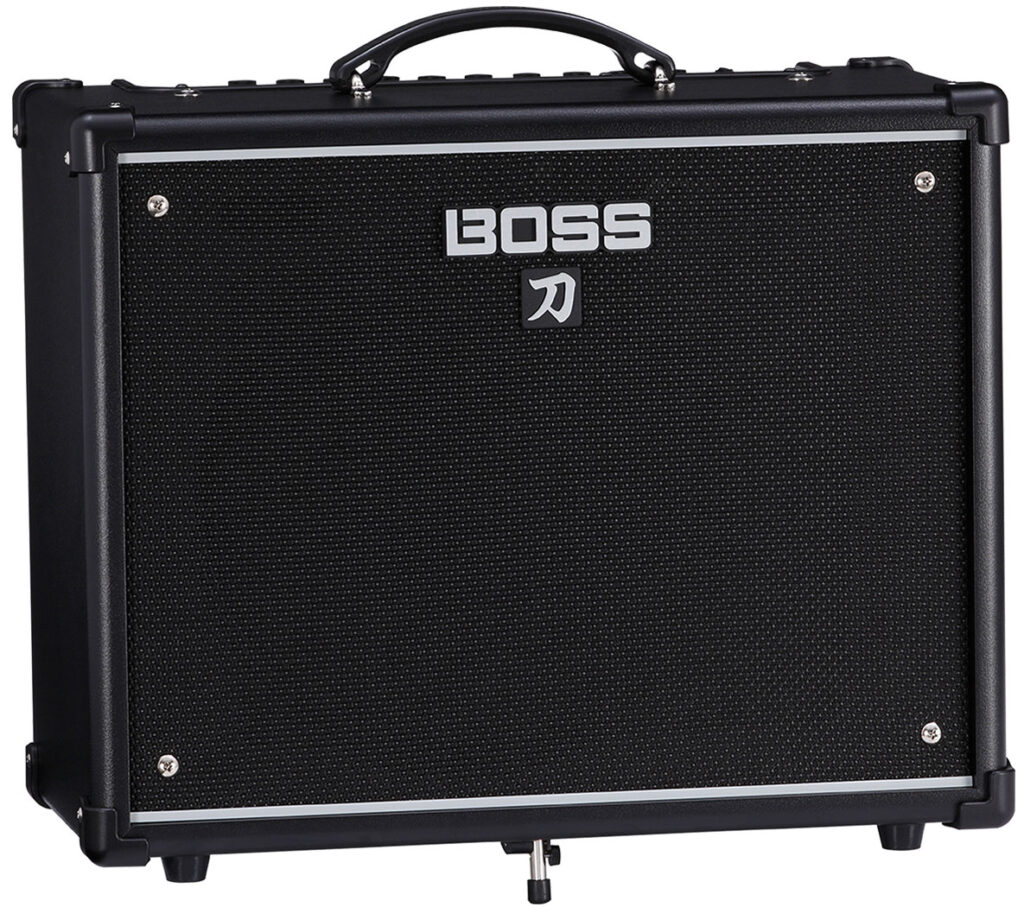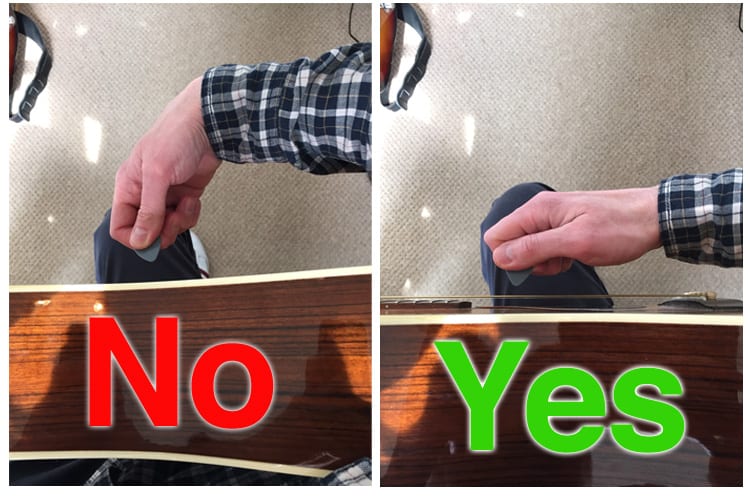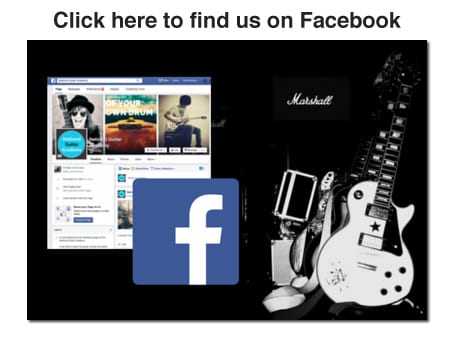You need to understanding amp channels
The first thing you need to understand is that most amplifiers have different ‘channels’. These make global changes to the sound the amp creates.
All amps have a ‘clean’ channel. This is the pure tone that’s delivered from your guitar and the speaker inside the amp.
Most amps have another channel, that delivers a ‘dirtier’, distorted sound. This is sometimes called ‘gain’, ‘overdrive’ or ‘distortion’. These terms are all used interchangeably and broadly mean the same thing. It makes the guitar sound ‘fuzzy’.
Some amps have more than one gain channel, so this allows you to have three different and distinct sounds that you can switch between on-the-fly using a foot pedal that controls your amp.
Pro Tip: If you want an amp that will grow with you, consider picking up the BOSS Katana. This amp comes loaded with all the guitar tones you’ll need to play any style of music with ease. We especially love the clean tones you can get out of this thing (especially considering it’s a digital amp.)
It’s also the perfect amp for following along with the next section of this lesson.
Guitar Effects
Guitar effects can be fantastic fun and can drastically alter the sounds that you can create with your electric guitar. Entire books have been written on guitar effects; it’s a huge and complicated area in the guitar niche.
As a beginner guitarist it’s best not to use any effects beyond some gain/overdrive that you can get from your amp’s gain channel.
If you want to learn electric guitar quickly you have to focus on what’s most important. Effects are ‘garnish’ and we want to focus on the fundamentals first!
Don’t get me wrong, guitar effects are fantastic fun but they add another layer of complexity that beginner guitarists can do without.
In my experience beginner electric guitarists can very quickly get overwhelmed by all of the effect variables and if you start playing around with chorus and delay effects everything gets more complicated and it actually prevents you from mastering the basics quickly.
We want you to master the fundamental aspects of playing electric guitar first; things that you must know, like your pickups and amp’s EQ controls.
So please, choose to keep things simple! 🙂
How to make your amp sound good
Let’s create a standard clean tone you can use as your ‘default’ guitar sound. It’s time to EQ your amp.
On your amp you will have a power button and some other buttons that allow you to switch channels.
- You will also have three EQ controls labelled: ‘low’, ‘mid’ and ‘high’. These are sometimes called ‘bass’, ‘mid’ and ‘treble’.
- Usually they can be turned from 0-10. Just set them all to 5.
- Turn off any onboard effects your amp has (delays, chorus, flangers etc).
- Select your clean channel.
- On your guitar, turn your volume control up to 10. Turn your tone control to its midpoint.
This is your standard setup. This is your ‘basecamp’. A point you can return to whenever you want to play with a consistent and predictable tone.
Now tweak the sound with your pickup selector
Now try strumming a few chords and see how the sound changes as you switch between different pickups on your guitar.
Can you hear how the sound changes a lot? If you want to learn electric guitar you have to get comfortable with this.
Find a tone you like here and make it your standard go-to sound.
Creating an overdrive sound
Now activate your gain/overdrive channel. This channel has separate controls so you may need to adjust your amp’s controls to alter the volume for this channel.
You will also notice that you have some extra controls that are specific to this channel. This dial will be labelled ‘gain’ or ‘overdrive’. This control adjusts the amount of distortion that will be applied.
When it’s turned up to 10 your sound will be very fuzzy. When it’s turned down to 0 your sound will be cleaner, and possibly quieter or even silent.
Play around with your pickups here and find a tone you like. This can be your standard distorted sound.
With these two sounds clearly defined, a clean sound and a distorted sound, you have a solid platform to learn electric guitar without getting bogged down in unpredictable amp settings and complicated effects.
Important: Take care to ensure that your guitar is always in-tune. The only thing worse than an out of tune guitar is an out of tune guitar that’s being amplified!
How to learn electric guitar step 6: Learn how to strum
If you want to learn electric guitar, you MUST be able to strum chords rhythmically.
Strumming will take you time to perfect and as you learn you must ensure you’re not engraining bad technique.
This is what good strumming looks like from the guitar player’s perspective:
- Notice that the wrist is locked and the big strumming motion is mostly coming from the elbow.
- Check out the way the pick is being held too.
- The whole arm is a pivot. Think of it as a single ‘piece of wood’.
- The pick is like a nail through the piece of wood, at the end. Pointing in, at the strings.
If your current strumming technique is very different to this, you will initially feel like you’re ‘dragging’ the pick over the strings when you try this. (And you are, that’s the pick’s job! That’s what it’s meant to do.) This feeling can cause a bit of discomfort, but it will pass quickly.
This is a huge pillar of learning guitar. In many ways, learning to strum IS learning guitar. Check out this must-read guide to learn a lot more about how to strum with rhythm and musicality.
Check it out! How To Strum A Guitar: The Ultimate Guide
How to hold your pick properly
A big part of understanding how to learn electric guitar is understanding how you make contact with the guitar. This seems like a small detail, but it’s huge!
The pick is being held too far back here:
This is much better.
Lots of beginners find picks difficult to use so they take the path of least resistance and start strumming with their fingers or (heaven forbid) their thumb.
This might feel easier to begin with, but playing with your thumb is a terrible, limiting habit. Playing with your fingers is fine, of course.
As a guitarist, you need to be able to play with a pick AND your fingers. Practice with both, but do not abandon the pick.
If you want to know how to learn electric guitar, you must be comfortable using a guitar pick.
Be careful not to ‘swan-neck’ your wrist
Your arm should go straight across, parallel to the guitar’s body, with the pick pointing inwards.
The swan-neck shape makes it impossible to deaden, syncopate or do pretty much any right hand technique. (This won’t be a problem if you’re an absolute beginner, but it will hold you back hugely when you’re an intermediate player.) The swan-neck wrist is to be avoided at all costs.
Download our lead guitar cheat-sheet to make things easier
It's hard to understand which scales work with which keys.
So we created a cheat-sheet! A key and scale-finder that you can use again and again.

Get your personalised guitar-learning plan 🎸
Get a custom guitar-learning plan here: Click here for GuitarMetrics™
World-Class Guitar Courses 🌎
Learn from the world's best guitar educators: Click here for our guitar courses
How to learn electric guitar step 7: Only play songs you love
Here are 3 objective facts you need to have on your radar as a guitar-learner:
- Fact 1) You’re much more likely to successfully learn the guitar if you practice a lot.
- Fact 2) You’re much more likely to practice if you enjoy practicing.
- Fact 3) You’re much more likely to enjoy practicing if you LOVE the music you play during your practice time.
Playing music you love isn’t a luxury for a guitar learner. It’s required. So forget about learning stuff like ‘happy birthday’ and ‘twinkle twinkle little star’. If your teacher wants you to play that stuff you should fire him immediately! 🙂
Tilt the scales in your favour by learning music you love. This article of ours will be a big help and a good source of ideas: 10 Easy Songs For Beginners
How to learn electric guitar step 8: Find a good teacher
Don’t rely on YouTube tutorials! There’s lots of great guitarists on YouTube, but not many great guitar teachers. And there’s a huge difference between those two things. Trust me, I own two guitar schools! 🙂
It can take quite a few attempts to find a teacher that’s right for you. That’s normal and you should expect it. It’s all part of understanding how to learn electric guitar.
A good guitar teacher will totally transform your chances of successfully learning the instrument, so keep looking and don’t get discouraged if after 3 or 4 teachers you still haven’t found one that ‘clicks’ with you.
How to learn electric guitar step 9: Practice in a smart way
Over many years I’ve learned that the difference between good guitarists and not-so-good guitarists is not whether they have long fingers or short fingers or whether they have big hands or small hands or whether they come from a musical family or not. ‘Talent’ is a teeny, tiny part of the equation.
The thing that makes a difference is practice. If you want to learn electric guitar you need to be smart about how you approach practicing.
‘How much should I practice?’
Ideally you want to practice guitar for about fifteen minutes per day, but even five minutes a day will see you make clear & satisfying progress.
Occasionally I’ve had students who say things like, “Sorry, I didn’t get any practice in this week. I set aside a few hours on Sunday, but then something came up.”
Don’t try and cram all your practice into one day.
For one thing, life being what it is, things often WILL come up. (That’s life, right?)
Perhaps more importantly though, even if you’re 100% certain you have that day free, you’re giving yourself a HUGE workload.
It’s much better to keep things bitesize. Fifteen minutes a day is manageable, won’t stress you out too much and if something comes up, it’s ok. (Losing 15 minutes practice time is no big drama.)
What Type of Guitarist Are You?
Take our 60-second quiz & get your results: Take The Quiz
Join the world's best online guitar school 🌎
- Get your own personalised guitar learning plan (customised just for YOU).
- World-class online guitar courses. Learn at your own pace.
- Community Campus & Learning Forum - A friendly community! Connect with our team & students. 😊
- Beginner Song library with chordsheets, tabs and tips. (Songs suitable for all levels!)
- Regular live streams, seminars and Q&A sessions - Learn from world-class guitar educators. Get all your questions answered!
Click here to learn more about National Guitar Academy membership 
Cool Guitar T-shirts 😎
Look cooler! Check out our merch: Click here to see our merch store
Want free guitar tips and video lessons delivered to your inbox?
Join over 100,000 guitar-learners and subscribe to our guitar-tips-by-email service. (It's free.)
We'll send you a series of lessons that will move you to the next level of your guitar journey.
Learn how everything fits together quickly, easily and effectively. We share ninja tips (for instant fun!) but also timeless fundamentals that will deepen your understanding.

Popular Lessons
How To Learn Guitar: An 11-Step Programme For Beginners
How To Choose The Perfect Beginner Guitar
More Cool Guitar Stuff
Learn about National Guitar Academy: About Us
Join us on Facebook for daily guitar tips.
Listen to our Learn Guitar Podcast for rapid guitar progress.
Check out our free chord lessons.
Where should we send it?
Get our best guitar tips & videos













